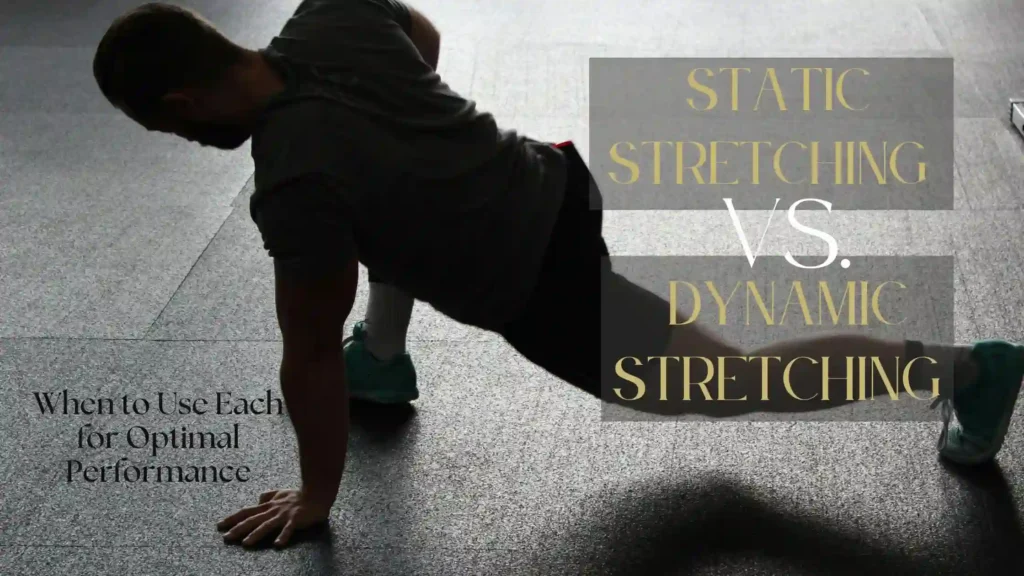When it comes to flexibility and injury prevention, understanding static vs dynamic stretching is essential for any fitness routine. However, many people struggle to determine the best time to use each type.
Static stretching involves holding a muscle in a fixed position for an extended period, promoting flexibility and relaxation. It’s most effective after a workout or during cooldowns to reduce muscle stiffness and enhance overall range of motion.
Dynamic stretching, in contrast, consists of controlled, active movements that increase blood flow and warm up muscles before exercise. This type of stretching is ideal for priming the body for movement, improving mobility, and reducing the risk of injury.
Both forms of stretching serve a vital role in a well-balanced fitness routine. Dynamic stretching is best for warm-ups, while static stretching supports recovery and long-term flexibility. Knowing when and how to use each can optimize performance, prevent injuries, and enhance overall movement efficiency.
What is Static Stretching?
Static stretching involves holding a position for a specific muscle group for 15 to 60 seconds, allowing the muscles to lengthen and relax. It is best performed after a workout when muscles are warm.
Examples of Static Stretches
- Hamstring Stretch: Sit with one leg extended and the other bent, reaching toward your toes on the extended leg.
- Quadriceps Stretch: Stand on one leg and pull the opposite foot toward your glutes.
- Child’s Pose: From kneeling, extend your arms forward and sit back on your heels.
Benefits of Static Stretching
- Increases flexibility by elongating muscles over time.
- Reduces muscle tension and relieves post-workout tightness.
- Promotes relaxation by engaging the parasympathetic nervous system.
- Aids recovery by enhancing circulation and reducing soreness.
What is Dynamic Stretching?
Dynamic stretching consists of controlled, repetitive movements that move muscles and joints through their full range of motion. It is ideal for a pre-workout warm-up because it prepares the body for physical activity.
Examples of Dynamic Stretches
- Leg Swings: Swing one leg forward and backward in a controlled motion.
- Arm Circles: Extend arms outward and perform small-to-large circular motions.
- Walking Lunges: Step forward into a lunge, alternating legs as you move forward.
Benefits of Dynamic Stretching
- Improves blood circulation and warms up muscles.
- Enhances athletic performance by mimicking sport-specific movements.
- Reduces injury risk by gradually increasing joint and muscle elasticity.
- Boosts mobility for better movement efficiency.
Static vs. Dynamic Stretching: Key Differences
| Static Stretching | Dynamic Stretching | |
|---|---|---|
| Purpose | Improves flexibility and promotes relaxation | Warms the body and enhances performance |
| Best Timing | Best post-workout (cooldown) | Best pre-workout (warm-up) |
| Movement Type | Stationary, held poses | Active, continuous movements |
| Muscle Engagement | Targets specific muscles | Engages multiple muscle groups |
| Impact on Performance | Can temporarily reduce power | Boosts muscle activation |
Scientific Insight
- Studies show that prolonged static stretching before high-intensity activities can reduce muscle strength and power.
- Dynamic stretching activates the nervous system and increases muscle temperature, leading to better performance.
- A 2012 study from the Journal of Strength and Conditioning Research found that athletes who performed dynamic stretches had better sprint times and jump heights than those who engaged in static stretching before activity.
When to Use Static and Dynamic Stretching
Use Dynamic Stretching Before a Workout
- Increases blood flow to muscles.
- Enhances joint mobility and muscle activation.
- Prepares the nervous system for physical activity.
Pro Tip: Customize your dynamic warm-up based on your activity.
For runners, include leg swings, walking lunges, and high knees.
Use Static Stretching After a Workout
- Helps reduce muscle stiffness post-exercise.
- Improves long-term flexibility.
- Lowers stress levels and promotes relaxation.
Pro Tip: Hold each static stretch for at least 30 seconds to maximize flexibility benefits.
Common Misconceptions About Stretching
1. Stretching Prevents All Injuries
- Reality: Stretching reduces injury risk, but strength training, proper technique, and warm-ups are also essential.
2. Static Stretching is Bad Before Exercise
- Reality: Static stretching before intense activity can reduce muscle power, but it aids recovery when done after workouts.
3. You Must Stretch Every Muscle Daily
- Reality: Focus on targeted stretching for tight or overworked muscles rather than stretching aimlessly.
How to Incorporate Both Types of Stretching in Your Routine
Before Exercise (Warm-Up)
- Perform 5–10 minutes of dynamic stretching.
- Include sport-specific movements (e.g., jogging, agility drills).
After Exercise (Cooldown)
- Dedicate 5–10 minutes to static stretching.
- Focus on muscles worked during the session.
- Use rest days for deep flexibility work, such as yoga.
Conclusion
Understanding static and dynamic stretching allows you to optimize your warm-up, cooldown, and injury prevention strategy.
- Dynamic stretching primes your muscles for movement and boosts performance.
- Static stretching aids in recovery, relaxation, and long-term flexibility.
By incorporating both strategically, you will:
- Enhance performance.
- Reduce injury risk.
- Improve mobility.
Stretch smart, stay strong, and move better!
